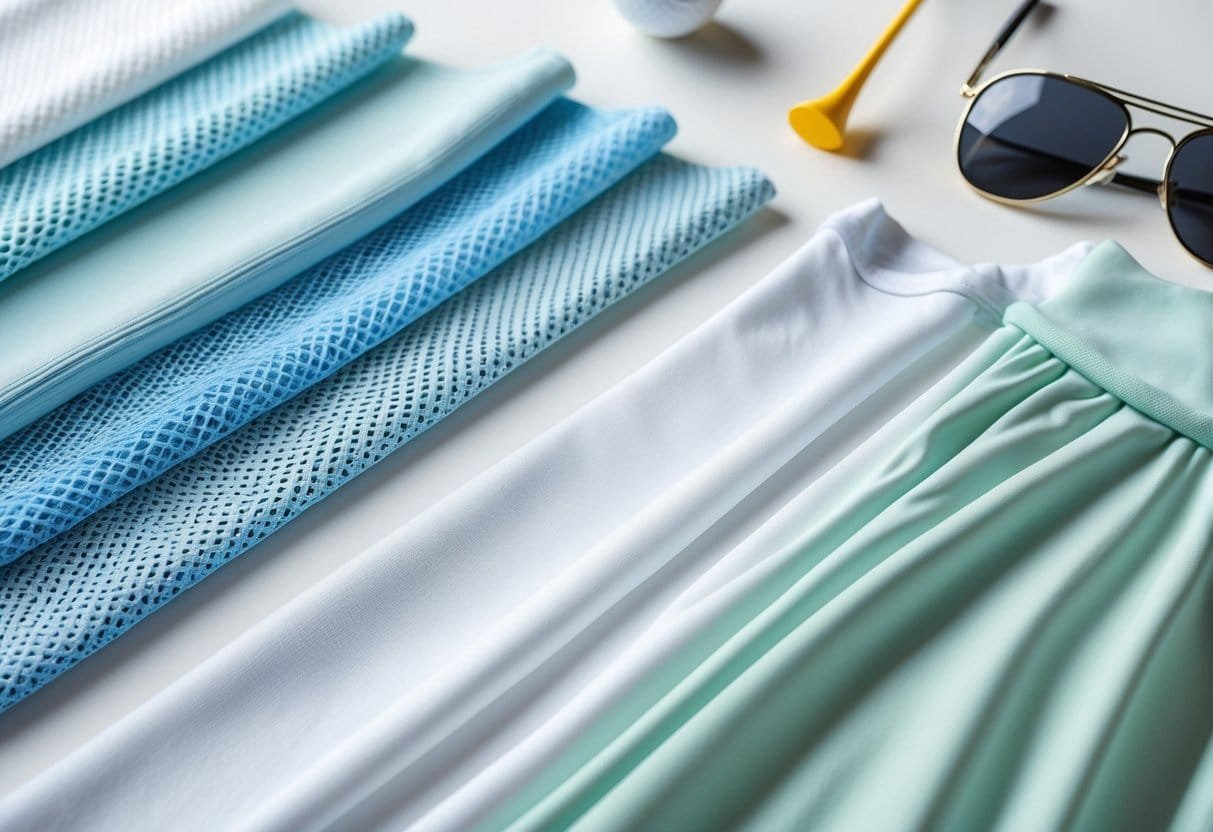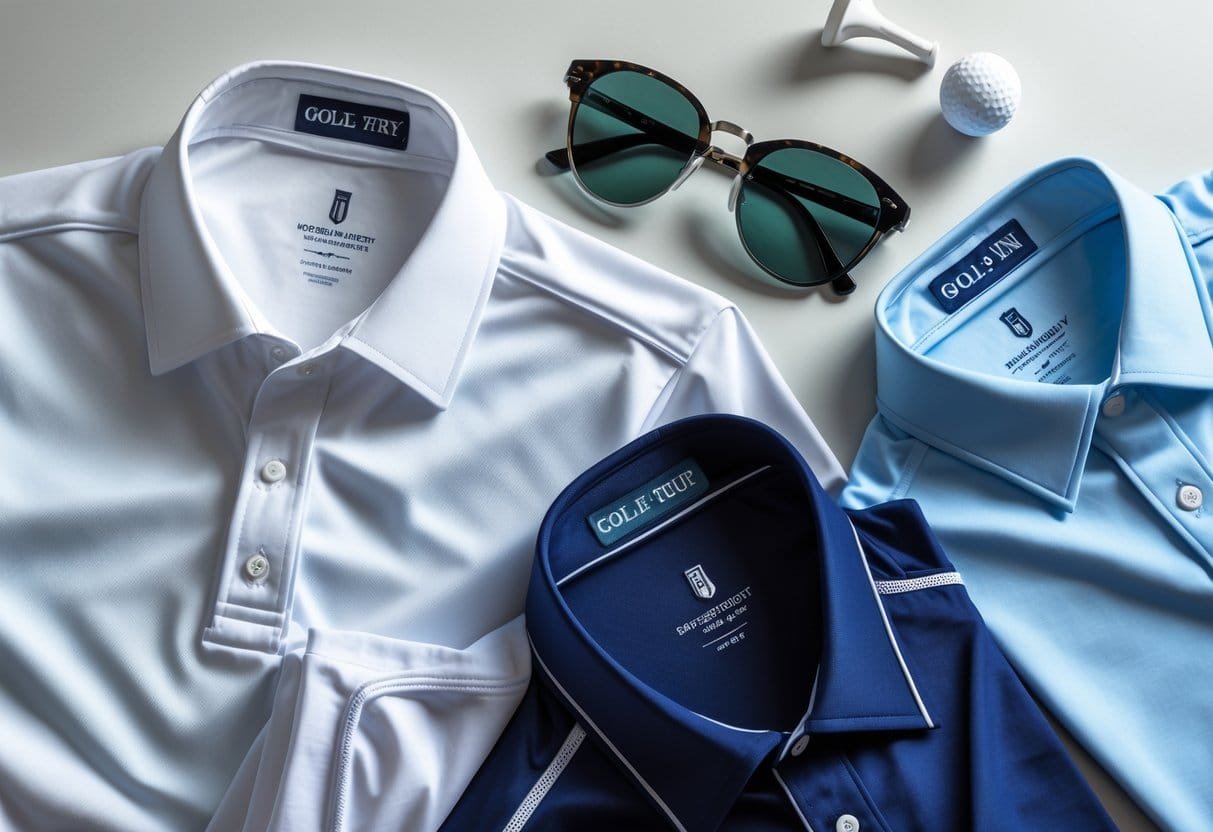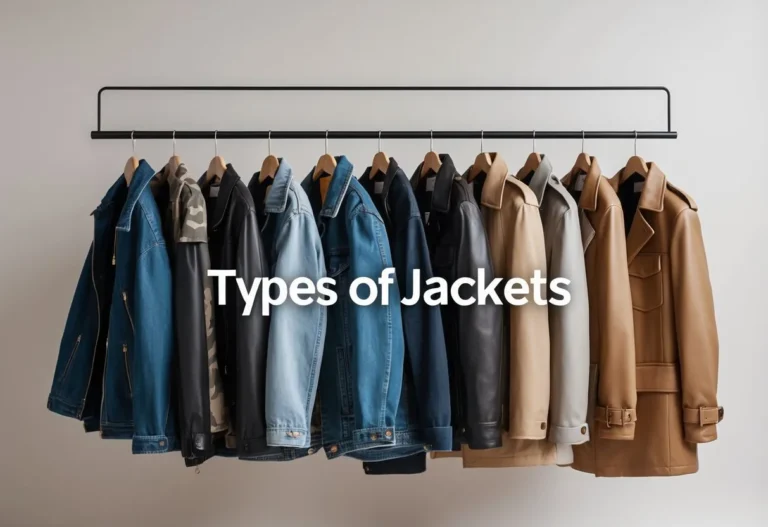Golf Shirt Materials: A Guide for Choosing the Right One
Choosing the right material for a golf shirt is crucial for comfort, performance, and durability on the course. Golf shirts come in a variety of fabrics including cotton, polyester, spandex blends, and wool, each offering different benefits like breathability, moisture-wicking, and UV protection. The best golf shirt material balances comfort, durability, and performance to keep the wearer cool, dry, and unrestricted during play.

Many golfers overlook how fabric choice affects their game and comfort. Modern golf shirts use advanced blends to enhance stretch and reduce odor, while traditional materials like cotton remain popular for their softness and breathability. Understanding these options helps pick a shirt suited to different weather conditions and personal preferences.
With improvements in fabric technology, players now have choices that combine style and function without sacrificing ease of care. Selecting the right fabric ensures longer-lasting shirts that support movement and maintain a crisp appearance throughout the round.
Table of Contents
Key Takeaways
- Comfort, durability, and breathability are key factors when choosing golf shirt materials.
- Fabric blends often provide better stretch and moisture control than natural fibers alone.
- Proper fabric choice helps maintain performance and comfort in varying weather conditions.
Popular Golf Shirt Materials

Golf shirts come in a few main fabrics, each with distinct features that affect comfort, durability, and care. Some prioritize moisture control, while others focus on softness or stretch. Understanding these differences helps choose the right shirt for the conditions and gameplay style.
Polyester
Polyester is a strong, synthetic fabric widely used in golf shirts for its durability and quick-drying properties.
It resists shrinking and fading, making it low-maintenance and easy to care for. Polyester wicks moisture away from the skin but is not as breathable as natural fibers.
Polyester shirts often have a smooth feel and retain their shape well after multiple washes. Blends may improve airflow by adding natural fibers or mesh panels.
The fabric offers natural UV protection and resists wrinkles, requiring little to no ironing. This makes polyester ideal for players seeking durability and easy care.
Cotton
Cotton is a natural fiber often chosen for its breathability and soft feel.
It offers good airflow and comfort, helping regulate temperature during play. Cotton absorbs moisture but dries slower than synthetic fabrics, which can leave the shirt feeling damp.
The material is easy to clean, machines well, and irons easily for a neat look. Cotton shirts tend to be affordable but may wear out faster with frequent use.
Cotton is ideal for golfers prioritizing comfort and classic styling, especially in moderate temperatures. It does not provide much UV protection unless specifically treated.
Blends
Blended fabrics combine fibers like cotton, polyester, and sometimes spandex to offer balanced properties.
Cotton-polyester blends enhance durability and reduce shrinkage while maintaining softness and breathability. Adding spandex provides stretch for better mobility.
These blends wick moisture better than pure cotton and dry faster while keeping a comfortable, less sticky feel. They typically resist wrinkles and maintain shape over time.
Blends suit golfers who want a mix of comfort, performance, and ease of care in one shirt. The exact blend percentages affect the balance between breathability, flexibility, and durability.
Performance Fabrics
Performance fabrics are specially designed to maximize comfort and support athletic movement.
They often include synthetic fibers with moisture-wicking, quick-drying, and odor-resistant treatments. These materials may have added UV protection and stretch to support wide swings.
Performance golf shirts are lightweight and breathable, helping keep players cool on hot days. They can include mesh panels or specialized weaves for improved airflow.
Common performance fabrics mix polyester with spandex or other fibers. They require care that avoids high heat to maintain stretch and functionality.
These fabrics are best for golfers demanding high mobility, effective moisture management, and long-lasting wear.
Key Factors to Consider When Choosing Golf Shirt Materials

Choosing the right material impacts how well a golf shirt performs during a round. The fabric must handle sweat, allow air flow, feel good against the skin, and hold up over time.
Moisture Wicking
Moisture wicking is essential for comfort on the course. It means the fabric pulls sweat away from the skin to the shirt’s surface, where it can evaporate quickly. This helps the player stay dry and prevents the cold, sticky feeling that comes from sweat-soaked fabric.
Polyester and polyester blends usually offer the best moisture-wicking properties. Natural fibers like cotton wick moisture less effectively but feel softer. Some advanced fabrics also include anti-odor and quick-dry features, which help maintain freshness and comfort during long rounds.
Breathability
Breathability allows air to pass through the fabric, cooling the body and reducing sweat buildup. A breathable shirt helps maintain a comfortable temperature, even in warm weather.
Cotton is known for good breathability due to its natural fibers. Polyester alone is less breathable but improves with blended or mesh designs. Avoid materials that trap heat, like heavy nylon or 100% polyester, unless they have ventilation panels. Lightweight materials with open weaves or perforations increase airflow without sacrificing durability.
Comfort
Comfort depends on how the fabric feels on the skin and how it supports movement. Softness, stretch, and smoothness all contribute to comfort during swings and movement across the course.
Cotton is soft and pleasant against the skin but less elastic. Adding spandex improves stretch and shape retention, letting golfers move freely without restriction. Performance blends of polyester and cotton balance softness and flexibility. Seamless designs and smooth finishes reduce irritation and enhance wearability for extended play.
Durability
Durability is key for shirts worn and washed frequently. The fabric should resist fading, shrinking, and damage to maintain its look and fit.
Polyester excels in durability. It stands up well to washing and sunlight without losing shape. Cotton offers moderate durability but can shrink or fade faster. Blends of cotton and polyester combine the strengths of both, creating shirts that last while remaining comfortable. Thicker fabrics and quality stitching also contribute to longer-lasting golf shirts.
Performance and Technical Fabric Innovations

Golf shirt fabrics today focus on improving comfort, durability, and protection. Advances in technology help golfers stay dry, move freely, and guard against sun damage. These improvements make clothing more practical for long hours on the course.
UV Protection
Golfers spend many hours exposed to the sun, so fabrics with UV protection are important. Shirts with a UPF (Ultraviolet Protection Factor) rating of 30 or higher block most harmful UV rays. This protection reduces the risk of sunburn and long-term skin damage.
UV-protective fabrics are often tightly woven or treated with special coatings. This feature does not add weight or affect breathability. It gives golfers confidence to play without needing extra sunscreen on covered skin.
Choosing a golf shirt with built-in UPF protection offers reliable sun defense. This technology is especially valuable during peak sunlight hours and on sunny days.
Antimicrobial Treatments
Sweat can cause odor and bacteria buildup in golf clothing. Antimicrobial treatments help prevent this by inhibiting bacteria growth on fabric. This keeps shirts smelling fresher for longer and reduces the need for frequent washing.
These treatments are often applied as finishes during manufacturing. They do not change the feel or appearance of the fabric. The effectiveness depends on how well the fabric is cared for after purchase.
Antimicrobial golf shirts are ideal for warm or humid conditions. They improve comfort and hygiene, especially during extended play or when rewearing the same shirt.
Stretch Technologies
Flexibility is vital in golf apparel to allow a full range of motion during swings. Four-way stretch fabrics are designed to stretch both vertically and horizontally. This means the garment moves with the body instead of restricting it.
These fabrics usually combine polyester, spandex, or elastane fibers. They maintain shape and resist sagging after repeated use. Stretch technology enhances comfort and supports better performance by preventing chafing and tightness.
Golf shirts with stretch features suit players who value ease of movement. They offer unrestricted swinging motion without compromising fit or style.
Golf Shirt Materials for Different Weather Conditions

Choosing the right golf shirt material depends heavily on the weather. Each climate demands fabrics that balance comfort, moisture control, and flexibility to support a smooth swing. Different materials offer distinct benefits suited to hot, cold, or humid conditions.
Hot Climates
In hot weather, moisture-wicking fabrics like polyester blends are ideal. They pull sweat away from the skin and dry quickly, keeping the golfer cool and comfortable. Lightweight and breathable weaves allow air to flow, reducing overheating.
Materials with added stretch, such as polyester with spandex, also help by allowing full shoulder rotation without restriction. Cotton shirts are less suitable here as they absorb sweat, become heavy, and slow drying, which can lead to discomfort and distraction during play.
Cold Weather
For cold weather, materials that provide insulation while managing moisture are key. Merino wool is an excellent choice because it traps warmth but still breathes well. It also naturally resists odors, which is a benefit during long rounds.
Performance polyester works well as a base layer or standalone shirt in cold conditions due to its ability to regulate temperature and wick moisture. Cotton is less practical for cold weather on the course, as it retains moisture and can cause chills.
Rainy or Humid Environments
In humid or rainy weather, moisture-wicking and quick-drying fabrics are necessary. Polyester blends excel because they do not hold water and help maintain comfort by pulling moisture away from the body.
Cotton and heavy blends should be avoided because they absorb water, becoming heavy and uncomfortable. Antimicrobial treatments on some synthetic shirts also reduce odor caused by sweat and dampness, which commonly occur in these conditions. Breathability remains important to prevent overheating in sticky, wet environments.
Sustainability and Eco-Friendly Options

Sustainable golf shirt materials help reduce environmental impact while still offering comfort and performance. Some fabrics use recycled sources, while others come from natural plants grown without harmful chemicals. These options also support more responsible manufacturing practices.
Recycled Polyester
Recycled polyester is made from plastic bottles or used textiles. This process lowers carbon emissions by about 50% compared to making new polyester. It is lightweight, durable, and moisture-wicking.
Players appreciate recycled polyester for golf shirts, jackets, and wind-resistant gear because it balances comfort with eco-conscious production. Using this material helps reduce plastic waste and limits pollution from traditional synthetic fibers.
Organic Cotton
Organic cotton is grown without synthetic pesticides or genetically modified seeds. This farming method uses less water and helps protect soil from damage.
The fabric feels soft and breathable, making it a popular choice for casual golf polo shirts and trousers. It supports farmers practicing environmentally friendly agriculture and results in fewer toxic chemicals released into the environment.
Bamboo Fabrics
Bamboo fabric comes from the fast-growing bamboo plant, which requires little water and no pesticides. This makes it a highly sustainable material.
The fibers are naturally soft, moisture-wicking, and have antibacterial properties. Golf shirts and base layers made with bamboo offer comfort and help manage sweat during play, while minimizing environmental impact.
Care and Maintenance Tips for Golf Shirt Fabrics

Proper care preserves the look and performance of golf shirts. Attention to washing techniques and drying methods helps maintain fabric quality, shape, and moisture-wicking features.
Washing Best Practices
Golf shirts should be washed in cold water to protect synthetic fibers and prevent shrinking. Before washing, sorting shirts by color and fabric type reduces color bleeding and damage to delicate materials.
Turning shirts inside out minimizes friction and protects logos or prints. Using a gentle detergent without bleach or fabric softeners keeps fabrics from losing their moisture-wicking and breathable properties. A gentle wash cycle with minimal agitation lowers wear and tear.
Pre-treating stains with mild detergent improves cleaning without harming fibers. Avoid over-washing by only cleaning shirts when needed to extend their lifespan.
Drying and Storage
Air drying golf shirts is the safest method to avoid shrinkage and fabric weakening. Hanging or laying shirts flat in a shaded, well-ventilated area prevents color fading from direct sunlight.
If using a dryer, low heat settings are essential to protect fibers and maintain moisture-wicking abilities. Prompt removal from the dryer prevents wrinkles.
For storage, folding shirts neatly or hanging on padded hangers helps maintain their shape. Shirts should be stored in a cool, dry place, away from moisture that can damage fabrics. Rotating shirts regularly prevents overuse and extends overall garment life.
Frequently Asked Questions

Choosing the right golf shirt material depends on breathability, durability, comfort, UV protection, and cost. The fabric also affects how easily a player moves and how well they stay cool and dry on the course.
What are the key factors to consider when selecting a material for a golf shirt?
Breathability and moisture-wicking ability are crucial for comfort. Durability ensures the shirt lasts through frequent use and washing.
UV protection matters for long time spent in the sun. The fabric’s stretch and fit also affect swing freedom.
How does the fabric of a golf shirt impact performance on the course?
Materials that wick sweat keep a player dry and focused. Stretch fabrics like those with spandex allow unrestricted movement.
Breathable fabrics help regulate body temperature. Heavy or non-breathable fabrics can cause discomfort and distraction.
What materials offer the best breathability and comfort for hot weather golfing?
Cotton and cotton blends are known for breathability and softness. Polyester blends with mesh panels can wick moisture while allowing airflow.
Avoid nylon and some polyester fabrics that trap heat and reduce cooling.
Are there benefits to choosing a golf shirt made from sustainable materials?
Natural fibers like merino wool are biodegradable and more environmentally friendly than synthetics. Sustainable materials often offer natural breathability and odor resistance.
Choosing sustainable fabrics supports eco-friendly production but may come at a higher price.
Which types of fabric provide the most durability in golf shirts?
Polyester and cotton-polyester blends are very durable. They resist fading, shrinking, and damage from sweat and sunlight.
High-quality denim and merino wool also offer strong longevity while maintaining comfort.
How do the costs of different golf shirt materials compare, and are they justified by their benefits?
Cotton shirts provide good value with comfort and breathability at a lower price. Polyester offers durability and low maintenance for a similar cost.
Premium fabrics like merino wool cost more but add benefits like temperature regulation and sustainability. Blends with spandex offer better fit and mobility, justifying moderate price increases.







